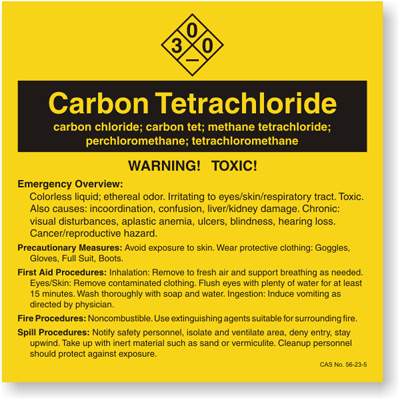
Image Source
Carbon tetrachloride is a clear, nonflammable, heavy liquid used as an industrial solvent and reagent with restricted commercial use. It is used in fire extinguishers, dry cleaning agents, grain fumigation, military smokescreens and as a raw material during the manufacturing process of other chemicals (1).
The toxicity profile has long been characterized with increased awareness and subsequent product bans:
- 1970: banned in consumer products
- 1978: banned in aerosol products
- 1986: banned in grain fumigation except for preserving museum artifacts (3)
Today, CCl4 is mainly used in the synthesis of chlorofluorocarbons (CFCs), which are used as heat transfer agents in refrigerating equipment and as aerosol propellants (2).
Exposures
CCl4 vapors can be inhaled occupationally by workers or via direct skin contact while the general population may be exposed by breathing air, smoking cigarettes, consuming food/water and contact with contaminated soil (3).

Mechanism of Action (3, 4)
CCl4 is metabolized primarily in the liver where it is converted to the trichloromethyl radical (CCl3) via the cytochrome p450 isoform CYP2E1. The CCl3 radical then does the following:
- Lipid peroxidation: free radicals travel to smooth ER and cause lipid peroxidation and other forms of oxidative damage by attacking and destroying polyunsaturated fatty acids. This disrupts the permeability of mitochondria, endoplasmic reticulum and plasma membranes. Without the ability to exchange ions, there is cellular accumulation of calcium resulting in further cell damage. This occurs within the first 10-15 minutes of exposure.
- Biotransformation: Converts to trichloromethyl peroxy radical (OOCCl3) and chloroform (CHCl3). Additionally, it is oxidized to produce hexachloroethane (Cl3CCCl3)
These radicals then bind to cellular molecules (nucleic acids, proteins, lipids) and impair processes including cellular respiration, lipid metabolism and fatty degeneration. Free fatty acids then accumulate in the liver resulting in hepatomegaly and other hepatic toxicities. This occurs 10 – 12 hours after exposure.
CCl4 also activates tumor necrosis factor (TNF) alpha, nitric oxide (NO) and transforming growth factors (TGF)-alpha and beta which trigger a signaling cascade resulting in fibrosis and cell death.
Target Organs
Target organs include: endocrine (glands, hormones), liver, CNS, eyes, lungs, liver, kidneys, skin (2).
Treatments (2, 3)

Image Source
- Anecdote: N-acetylcysteine may reduce severe complications
- Emergency Treatment:
- Decontamination
- Artificial respiration (i.e. demand-valve resuscitator, bag-valve-mask device, or pocket mask)
- Do not induce vomiting
- Basic Treatment:
- Administer oxygen
- Eye contamination: flush eyes immediately with water or irrigate with 0.9% saline (NS)
- Ingestion: rinse mouth and administer activated charcoal
- Dermal Exposure: cover burns with sterile dressings after decontamination
- Advanced Treatment:
- Orotracheal or nasotracheal intubation
- Positive-pressure ventilation techniques
- Vasopressors if patient is hypotensive
- Chronic Exposure: no treatment exists
Biomarkers
CCl4 can be detected by gas chromatography in blood, serum, and adipose tissue (3). That being said, any detectable blood level of CCl4 is indicative of exposure. Indirect biomarkers of CCl4 exposure include baseline liver function tests, liver injury tests and renal function tests. In suspected high exposures, clotting studies, chest X rays and electrocardiograms are indicated (3).
CCl4 toxicity Summary
References
(1) Morrison RD, Murphy BL, Doherty RE. 12 – chlorinated solvents. Environmental Forensics. 1964:259-277. http://www.sciencedirect.com/science/article/pii/B9780125077514500343. doi: https://doi.org/10.1016/B978-012507751-4/50034-3.
(2) National Center for Biotechnology Information. PubChem Database. Carbon tetrachloride, CID=5943, https://pubchem.ncbi.nlm.nih.gov/compound/Carbon-tetrachloride#section=Overview (accessed on July 8, 2020)
(3) “Case Study 8: Carbon Tetrachloride Toxicity.” Institute of Medicine. 1995. Environmental Medicine: Integrating a Missing Element into Medical Education. Washington, DC: The National Academies Press. doi: 10.17226/4795.
(4) Weber LW, Boll M, Stampfl A. Hepatotoxicity and mechanism of action of haloalkanes: carbon tetrachloride as a toxicological model. Crit Rev Toxicol. 2003;33(2):105-136. doi:10.1080/713611034
